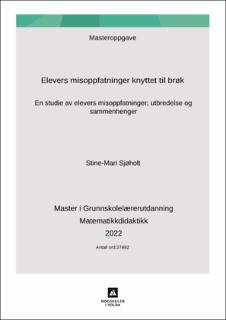Elevers misoppfatninger knyttet til brøk. En studie av elevers misoppfatninger; utbredelse og sammenhenger
Abstract
Sammendrag
Denne studien ser på misoppfatninger knyttet til brøkforståelse. Tidligere studier indikerer at elevers brøkforståelse er essensielt for forståelse og prestasjoner innen matematikk i videre skoleløp (Bailey et al., 2012; Booth & Newton, 2012; Siegler et al., 2012; Tsai & Li, 2017). Hensikten med studien har vært å undersøke sammenhenger og utbredelse av misoppfatninger knyttet til brøk hos elever på 5. trinn. Studien tar utgangspunkt i forskningsspørsmålene: Hvilken misoppfatning knyttet til brøk ser man mest av på 5.trinn? Hvilke sammenhenger kan man finne mellom misoppfatningene?
Studien er en mixed-methods studie, med en explanatory-sequential approach. Her vektlegges det kvantitative, men følges opp av en forklaring gjennom kvalitativ data. Ved å bruke mixed-methods kan man få en bredere og mer fullstendig forståelse av det fenomenet man undersøker. Studiens datamateriale er hentet fra utvalg av elever fra 5. trinn, med 91 elever fra fire ulike skoler. Den kvantitative dataen er samlet inn ved bruk av et oppgavesett. Resultatet og elevenes besvarelser av oppgavesettet la grunnlaget for kvalitative forskningsintervju. Hensikten med intervjuene var å få dypere forståelse for elevenes besvarelser og få et innblikk i elevenes tankegang og konseptuelle forståelse. Den kvantitative dataen er analysert med utgangspunkt i forskningsspørsmålene, og med støtte i det kvalitative gir det innsikt i hvordan fem utvalgte misoppfatninger er utbredt. Basert på analysene er det gjort videre undersøkelser av mulige sammenhenger.
Funnene i studien gir indikasjoner på at misoppfatninger med tilknytning til brøk er vanlig hos elever på 5. trinn. Det er også indikasjoner på at bestemte misoppfatninger har større utbredelse enn andre, og at det kan knyttes til grunnleggende aspekt ved elevenes konseptuelle forståelse. Aspektene har tilknytning til semiotikken og den meningen man gir til tegn. Her blir elevenes individuelle tolking og meningsskaping vektlagt. Abstract
This study explores the misconceptions in relation to fractions. Previous studies indicate that students’ understanding of fractions is essential for further understanding and achievements in mathematics (Bailey et al., 2012; Booth & Newton, 2012; Siegler et al., 2012; Tsai & Li, 2017). The purpose of this study has been to investigate the connections and prevalence of misconceptions related to fractions amongst 5th grade students. The study is based on the research questions: Which misconception, related to fractions, is most common in 5th grade? Which connections can be found between the misconceptions?
This study is a mixed-methods study, with an explanatory-sequential approach. There is an emphasis on the quantitative, followed by an explanation through qualitative data. By using mixed-methods, one can get a broader and more complete understanding of the phenomenon in question. The study’s data is retrieved from a selection of 5th grade students, with 91 students from four different schools. The quantitative data was collected using testing as a method. Based on the quantitative results and students’ answers, research interviews were conducted. The purpose of the interviews was to gain a deeper understanding of the students’ answers and an insight into the students’ thinking and conceptual understanding. The analysis of the quantitative data, with support from the qualitative data, provides an insight into the prevalence of five selected misconceptions. Based on these analysis’, further investigations were done as to which connections could be found.
The results of this study indicates that misconceptions associated with fractions are common amongst 5th grade students. There are also indications that certain misconceptions are more prevalent than others, and that these can be linked to basic aspects of students’ conceptual understanding. These aspects are related to semiotics and the meaning one gives to signs. Here, the students’ individual interpretation and construction of knowledge is emphasized.
